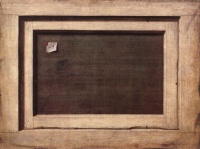Recto and verso
From The Art and Popular Culture Encyclopedia
|
Related e |
|
Featured: |
The recto and verso are respectively the "front" and "back" sides of a leaf of paper in a bound item such as a codex, book, broadsheet, or pamphlet. In languages written from left to right (such as English) the recto is the right-hand page and the verso the left-hand page. These are terms of art in the binding, printing, and publishing industries, and can be applied more broadly to any field where physical documents are exchanged.
The term recto-verso describes two-sided text. The terms are important in the field of codicology, where each physical sheet of a manuscript is numbered and the sides are referred to as recto and verso. Critical editions of manuscripts will often mark the position of text in the original manuscript, or manuscripts, in the style '42r.' or '673vº'.
The use of the terms 'recto' and 'verso' are also used in the codicology of manuscripts written in right-to-left scripts, like Syriac, Arabic and Hebrew. However, as these scripts are written in the other direction to the scripts witnessed in European codices, the recto page is to the left while the verso is to the right. The reading order of each folio remains 'first recto, then verso' regardless of writing direction.
The terms are carried over into printing; recto-verso is the norm for printed books, but was an important advantage of the printing-press over the much older Asian woodblock printing method, which printed by rubbing from behind the page being printed, and so could only print on one side of a piece of paper. The distinction between recto and verso can be convenient in the annotation of scholarly books, particularly in bilingual edition translations.
The "recto" and "verso" terms can also be employed for the front and back of a one-sheet artwork, particularly in drawing. A recto-verso drawing is a sheet with drawings on both sides, for example in a sketchbook—although usually in these cases there is no obvious primary side. Some works are planned to exploit being on two sides of the same piece of paper, but usually the works are not intended to be considered together. Paper was relatively expensive in the past; indeed good drawing paper still is much more expensive than normal paper.
By book publishing convention, the first page of a book, and sometimes of each section and chapter of a book, is a recto page, and hence all recto pages will have odd numbers and all verso pages will have even numbers.
In some early printed books (e.g. João de Barros's Décadas da Ásia), it is the folios ("leaves"), rather than the pages, that are numbered. Thus each folio carries a consecutive number on its recto side, while on the verso side there is no number.
Idioms in modern languages
Le mode recto verso is an idiomatic expression in French that means, literally, "two sides of a sheet or page", but figuratively means that two things are basically the same, or that they are different but closely related. This is analogous to, (and maybe even cognate to) some idioms in English such as "two sides of the same coin" or "six of one and half a dozen of the other".
See also


